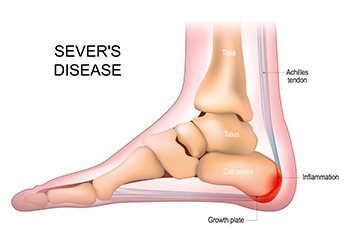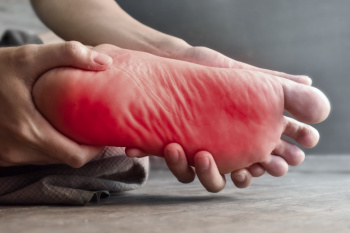
Sever’s disease is a common source of heel pain in growing children, particularly those who are active in sports. It occurs when the growth plate in the heel becomes inflamed, often due to repetitive stress or overuse. Symptoms include tenderness, swelling, and pain in the back of the heel that worsens during physical activity. Risk factors include rapid growth, high levels of athletic activity, tight calf muscles, and wearing improper footwear. A podiatrist can evaluate the condition, recommend stretching and strengthening exercises, provide supportive footwear or orthotics, and offer strategies to reduce stress on the heel. If your active child has heel pain, it is suggested that you consult a podiatrist who can provide effective relief and management tips.
Sever's disease often occurs in children and teens. If your child is experiencing foot or ankle pain, see one of our podiatrists from Geller Foot Clinic. Our doctors can treat your child’s foot and ankle needs.
Sever’s Disease
Sever’s disease is also known as calcaneal apophysitis, which is a medical condition that causes heel pain I none or both feet. The disease is known to affect children between the ages of 8 and 14.
Sever’s disease occurs when part of the child’s heel known as the growth plate (calcaneal epiphysis) is attached to the Achilles tendon. This area can suffer injury when the muscles and tendons of the growing foot do not keep pace with bone growth. Therefore, the constant pain which one experiences at the back of the heel will make the child unable to put any weight on the heel. The child is then forced to walk on their toes.
Symptoms
Acute pain – Pain associated with Sever’s disease is usually felt in the heel when the child engages in physical activity such as walking, jumping and or running.
Highly active – Children who are very active are among the most susceptible in experiencing Sever’s disease, because of the stress and tension placed on their feet.
If you have any questions, please feel free to contact our office located in Lathrup Village, MI . We offer the newest diagnostic and treatment technologies for all your foot care needs.

Young children and adolescents may develop a variety of toe-related issues, some linked to growth and others caused by injury or infection. Nails that curve into the surrounding skin can lead to soreness and swelling. Structural changes, such as toes that overlap or curl, may influence balance and walking comfort. Active play and sports sometimes result in stubbed toes, sprains, or small fractures that cause persistent discomfort. Skin and nail infections, including those caused by fungi, can also affect appearance and function. Addressing these concerns early helps prevent long-term problems and supports healthy foot development. A podiatrist can pinpoint the cause, suggest effective treatment, and offer advice on proper footwear and daily care. If your child has ongoing toe pain, visible deformity, or unusual changes in nails or skin, it is suggested that you arrange a visit with a podiatrist for an accurate diagnosis and effective treatment solutions.
The health of a child’s feet is vital to their overall well-being. If you have any questions regarding foot health, contact one of our podiatrists of Geller Foot Clinic. Our doctors can provide the care you need to keep you pain-free and on your feet.
Tips for Keeping Children's Feet Healthy
- Make sure their shoes fit properly
- Look for any signs of in-toeing or out-toeing
- Check to see if they have Clubfoot (condition that affects your child’s foot and ankle, twisting the heel and toes inward) which is one of the most common nonmajor birth defects.
- Lightly cover your baby’s feet (Tight covers may keep your baby from moving their feet freely, and could prevent normal development)
- Allow your toddler to go shoeless (Shoes can be restricting for a young child’s foot)
- Cut toenails straight across to avoid ingrown toenails
- Keep your child’s foot clean and dry
- Cover cuts and scrapes. Wash any scratches with soap and water and cover them with a bandage until they’ve healed.
If you have any questions, please feel free to contact our office located in Lathrup Village, MI . We offer the newest diagnostic and treatment technologies for all your foot care needs.

Selecting proper footwear for trail running and mountaineering is essential for comfort, performance, and injury prevention. Shoe cushioning choices include high for maximum shock absorption, moderate for a balance of comfort and ground feel, and minimal for a natural, lightweight experience. Energy return is also important, as it helps reduce fatigue during long treks and challenging terrain. Proper fit, traction, and durability are key characteristics for safely navigating uneven or rocky surfaces. A podiatrist can evaluate your foot type, gait, and activity level to recommend the best running shoe for your needs. If you have sustained a foot or ankle injury while running, it is suggested that you consult a podiatrist who can provide treatment, and guide you on appropriate shoes to wear.
You should always make sure your running shoes fit properly in order to avoid injury. For more information, contact one of our podiatrists from Geller Foot Clinic. Our doctors can provide the care you need to keep you pain-free and on your feet.
Choosing the Right Running Shoe for Your Foot Type
Improper shoe sizing can cause a myriad of problems for your feet. Shoes that don’t fit you properly can lead to muscular imbalances in your body, which can result in foot, knee, and hip injuries.
Tips for Finding the Right Running Shoe
- Make sure you have a thumb’s width of wiggle room between the end of your longest toe and the front of the shoe.
- There should be little to no slipping at the heel
- Don’t assume your size in one shoe brand will be your size in another
- Do not lace up your shoes too tightly
- Walk around in the store with your new shoes before you buy them
If you have any questions, please feel free to contact our office located in Lathrup Village, MI . We offer the newest diagnostic and treatment technologies for all your foot care needs.

Diabetic peripheral neuropathy is a condition where prolonged high blood sugar damages the nerves, especially in the legs and feet. This nerve damage can cause tingling, burning, numbness, or sharp pain. Common causes include poorly managed diabetes, poor circulation, and prolonged elevated glucose levels. Among the risk factors are long-term diabetes, smoking, and high blood pressure. As the feet lose sensation, injuries may go unnoticed, leading to ulcers or infections. A podiatrist can detect early nerve damage, provide foot care guidance, and help prevent complications through regular screenings and protective strategies. If you experience unusual sensations or numbness in your feet, it is suggested that you visit a podiatrist for a thorough evaluation and effective relief and management tips.
Neuropathy
Neuropathy can be a potentially serious condition, especially if it is left undiagnosed. If you have any concerns that you may be experiencing nerve loss in your feet, consult with one of our podiatrists from Geller Foot Clinic. Our doctors will assess your condition and provide you with quality foot and ankle treatment for neuropathy.
What Is Neuropathy?
Neuropathy is a condition that leads to damage to the nerves in the body. Peripheral neuropathy, or neuropathy that affects your peripheral nervous system, usually occurs in the feet. Neuropathy can be triggered by a number of different causes. Such causes include diabetes, infections, cancers, disorders, and toxic substances.
Symptoms of Neuropathy Include:
- Numbness
- Sensation loss
- Prickling and tingling sensations
- Throbbing, freezing, burning pains
- Muscle weakness
Those with diabetes are at serious risk due to being unable to feel an ulcer on their feet. Diabetics usually also suffer from poor blood circulation. This can lead to the wound not healing, infections occurring, and the limb may have to be amputated.
Treatment
To treat neuropathy in the foot, podiatrists will first diagnose the cause of the neuropathy. Figuring out the underlying cause of the neuropathy will allow the podiatrist to prescribe the best treatment, whether it be caused by diabetes, toxic substance exposure, infection, etc. If the nerve has not died, then it’s possible that sensation may be able to return to the foot.
Pain medication may be issued for pain. Electrical nerve stimulation can be used to stimulate nerves. If the neuropathy is caused from pressure on the nerves, then surgery may be necessary.
If you have any questions, please feel free to contact our office located in Lathrup Village, MI . We offer the newest diagnostic and treatment technologies for all your foot care needs.
